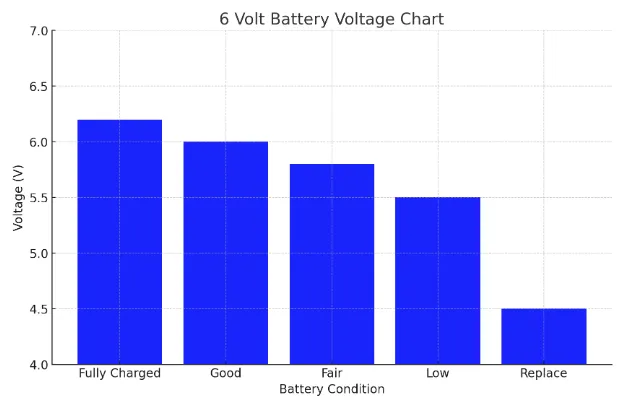How To Test 6V Battery With Multimeter
Testing a 6V battery with a multimeter is essential for anyone dealing with electronics, DIY projects, or routine maintenance. It’s a straightforward process that requires minimal tools and can provide invaluable information about your battery’s health and charge status.
In this article, we’ll guide you through the steps to test a 6V battery accurately using a multimeter.
Why Test a 6V Battery?
Testing a 6V battery is crucial to ensure it’s operating correctly and safely. Over time, batteries can lose their charge or become damaged. Regular testing can help determine if your battery needs charging or if it is time to replace it.

How To Test 6V Battery With Multimeter
Locate the Battery Terminals
The terminals are the two points on the battery where the electrical current enters and exits. A standard 6V battery has two terminals:
- Positive Terminal (+): This is typically marked with a plus sign (+). It’s the point from which the electrical current flows out of the battery. The positive terminal may also be slightly raised compared to the negative terminal.
- Negative Terminal (-): Marked with a minus sign (-), this terminal is where the current flows back into the battery. It’s usually flat or less prominent than the positive terminal.
Connect the Multimeter
Connecting the Probes
- Red Probe to Positive Terminal: Connect the multimeter’s red probe to the battery’s positive (+) terminal. The positive terminal is often marked with a plus sign and is typically the larger of the two terminals on a 6V battery.
- Black Probe to Negative Terminal: Attach the black (negative) probe of the multimeter to the negative (-) terminal of the battery. This terminal is usually marked with a minus sign.
Ensuring Good Contact
- Firm Connection: Ensure the probes are firmly connected to the battery terminals. A loose connection can result in inaccurate readings or no reading at all.
- Clean Terminals: If the battery terminals are dirty or corroded, clean them before attaching the probes. This ensures better contact and more reliable results.
Monitoring Polarity
- Correct Polarity: Always ensure the polarity is correct – red probe to positive, black probe to negative. Reversing the polarity might give incorrect readings and, in some cases, can damage the multimeter.
Adjusting Multimeter Settings
- Proper Range Selection: If your multimeter is not auto-ranging, set it to the correct voltage range that is just above the expected voltage of the battery (typically the 10V or 20V setting for a 6V battery).
- Mode Selection: Ensure the multimeter is set to measure DC voltage (indicated by a V with a straight line or a V with three dots underneath it).
Stabilizing for a Reading
- Hold Steady: Once connected, hold the probes steadily against the battery terminals for a few seconds to allow the multimeter to stabilize and provide an accurate reading.
- Reading the Display: Look at the multimeter display to read the voltage. Digital multimeters will show the voltage numerically, while analog multimeters will have a needle pointing to the voltage value on a scale.
Reading the Results
Ideal Voltage Range
- Fully Charged: For a 6V battery, a reading that is exactly or very close to 6 volts indicates a fully charged and healthy battery. This is the optimal reading you’re aiming for.
- Slightly Undercharged: A reading between 5.8V and 6.0V suggests the battery is slightly undercharged but still in good condition. It may require a short charging period to regain its full capacity.
Signs of Trouble
- Moderately Discharged: Readings between 5.4V and 5.7V indicate that the battery is moderately discharged. While it may still function, its performance could be compromised, and it should be recharged soon.
- Severely Discharged or Faulty: A reading below 5.4V, especially one that hovers around or below 4.5V, indicates that the battery is severely discharged or potentially faulty. Batteries in this state might not hold a charge well and could be nearing the end of their usable life.
No Reading
- Dead Battery: If the multimeter shows no reading or a value close to zero, the battery is likely dead and incapable of holding a charge. This usually means the battery needs to be replaced.
Fluctuating Readings
- Unstable Battery: If the multimeter reading is unstable or fluctuating significantly, it could indicate an issue with the battery’s internal cells or a loose connection. Such batteries are unreliable and might need further testing or replacement.
6 Volt Battery Voltage Chart

Can a multimeter test help predict the remaining lifespan of a 6V battery?
Yes, to an extent. Regular testing of a 6V battery with a multimeter can provide valuable insights into its health and potential lifespan. If a battery consistently shows readings close to its nominal value (around 6V for a fully charged 6V battery), it indicates good health and a longer lifespan.
On the other hand, if the battery often falls significantly below the optimal range or shows signs of unstable voltage readings, it might be nearing the end of its useful life.
Furthermore, if a battery regularly requires recharging to reach the ideal voltage range or fails to maintain a charge over time, it is a clear sign that it is wearing out. The rate of decline in performance can help predict how much longer the battery will be viable.
However, it’s important to note that while a multimeter can provide a snapshot of the battery’s current state, it cannot precisely determine the remaining lifespan. Factors like the battery’s usage history, maintenance, and storage conditions also significantly affect its lifespan.
Regular testing is just one part of comprehensive battery maintenance.
Conclusion
Testing a 6V battery with a multimeter is a simple yet essential process for maintaining the health and longevity of your batteries. By following these steps and understanding the results, you can ensure your batteries always work properly.
Regular testing can save you time and money in the long run.
Frequently Asked Questions
Can I test other types of batteries with a multimeter?
Yes, you can test different battery voltages using a multimeter, but ensure to adjust the voltage range accordingly. Check out our guides for other batteries, where we test AA battery and D battery with a multimeter.
What does it mean if there’s no reading on the multimeter?
No reading usually indicates a dead battery or a poor connection between the probes and the battery terminals.
Is it safe to test a battery with a multimeter?
Yes, following the safety precautions and using the multimeter correctly is safe.

Author
Alex Klein is an electrical engineer with more than 15 years of expertise. He is the host of the Electro University YouTube channel, which has thousands of subscribers.
